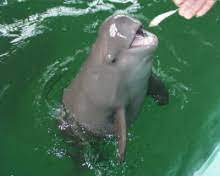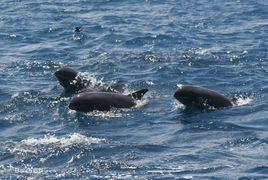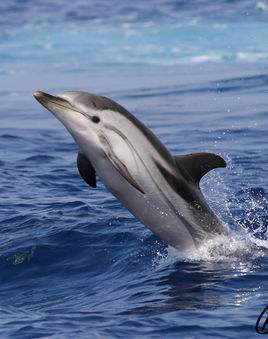
Kogia sima
Kogia sima,Kogia simus (Owen, 1866),Physeter simus Owen, 1866, Dwarf Sperm Whale, Dwarf Sperm Whale, Cachalot nain, Cachalot nain,Cachalote Enano, Cachalote Enano,,Owen's sperm whale
Dwarf Sperm Whale, no subspecies.The species of Dwarf Sperm Whale was not wi···

Kogia breviceps
Kogia breviceps,Pygmy sperm whale
Pygmy sperm whale, foreign name, no subspecies.Pygmy sperm whales move alone···

Physeter macrocephalus
Physeter macrocephalus,Sperm Whale, Cachelot, Pot Whale, Spermacet Whale ,Cachalot , Ballena Esperma, Cachalote, Giant Sperm Whale, Kacherat Whale
Sperm Whale, with no subspecies, has the largest brain in the animal kingdom···

Neophocaena phocaenoides
Neophocaena phocaenoides,Indo-Pacific Finless Porpoise,Delphinus phocaenoides G. Cuvier,, black finless porpoise, Indo-Pacific right porpoise
The Indo-Pacific Finless Porpoise has no subspecies.The Indo-Pacific Finless···

Neophocaena sunameri
Neophocaena sunameri,Narrow-ridged Finless Porpoise,Sand Mingli finless porpoise, narrow-ridged finless porpoise East Asian subspecies, finless porpoise East Asian subspecies, sea finless porpoise
The East Asian finless porpoise, also known as the Narrow-ridged Finless Por···

Neophocaena asiaeorientalis
Neophocaena asiaeorientalis,Yangtze Finless Porpoise,Narrow-ridged Finless Porpoise, Finless Porpoise,Neophocaena asiaeorientalis asiaeorientalis,Yangtze River Porpoise, Narrow-ridged Porpoise Yangtze
The Yangtze Finless Porpoise was once considered a subspecies of the narrow-···

Globicephala macrorhynchus
Globicephala macrorhynchus,short-finned pilot whale,Great nosed pilot whale, Great nosed pilot whale
Short-finned pilot whale is a warm-water oceanic species.Short-finned pilot ···

Feresa attenuata
Feresa attenuata,Pygmy Killer Whale, Orque pygmée,Orca Pigmeo,Delphinus intermedius,Small killer whale, small orca, small killer whale
The pygmy killer whale is also known as the pygmy killer whale. It is an ani···

Pseudorca crassidens
Pseudorca crassidens,False Killer Whale, Faux-orque,Orca Falsa,Phocaena crassidens Owen,Black whale, false killer whale, false pilot whale, false killer whale
False killer whale is the only species in the genus False killer whale of th···

Orcinus orca
Orcinus orca,Killer Whale, Orca,Epaulard, Orque, Espadarte, Orca,Orca assassina, killer whale
Killer Whale is the largest species in the dolphin family, and there is no s···

Peponocephala electra
Peponocephala electra,Toothy melon-headed whale, melon-headed dolphin
Melon-headed whale, also known as Melon-headed whale, has no subspecies. Its···

Grampus griseus
Grampus griseus,Risso's dolphin,Tattoo dolphin, Richter's dolphin, patterned whale, Richter's dolphin
The gray dolphin is called Risso's dolphin in English, and has no subspe···

Lagenodelphis hosei
Lagenodelphis hosei,Fraser's Dolphin,Hourglass dolphin, Freund's dolphin, Freund's dolphin
The Sarawak dolphin is called Fraser's Dolphin in foreign language, and ···

Delphinus
Delphinus,common dolphin,Common dolphin
Common dolphins are called common dolphins in English. There are two species···

Delphinus capensis
Delphinus capensis,Long-beaked common dolphin, Common Dolphin,Toothed dolphin, tropical dolphin, long-beaked dolphin
Long-beaked common dolphin, with two subspecies, is a warm-water species.Lon···

Stenella clymene
Stenella clymene,Short-snouted Spinner Dolphin,Clementine's dolphin, helmeted dolphin, spotted dolphin
Short-snouted Spinner Dolphin, with no subspecies, is a deep-water species i···

Stenella coeruleoalba
Stenella coeruleoalba,Striped dolphin,Blue and white dolphin, blue and white dolphin, striped dolphin
Striped dolphin, with no subspecies, is a common dolphin in the Pacific Ocea···

Stenella attenuata
Stenella attenuata,Pantropical spotted dolphin,Tropical spotted dolphin, weak dolphin, white-beaked dolphin
Pantropical spotted dolphin, with two subspecies, may be the most common cet···

Steno bredanensis
Steno bredanensis,Rough-toothed dolphin,Long-beaked dolphin, wrinkled-toothed dolphin
Rough-toothed dolphin, a dolphin with special teeth.Rough-toothed dolphins u···

Platanista gangetica gangetica
Platanista gangetica gangetica,Ganges River Dolphin,White puffer fish, Goto puffer fish
The Ganges River Dolphin is a nominative subspecies of the South Asian river···

Lipotes vexillifer
Lipotes vexillifer,Baiji, Yangtze River Dolphin,Baiji,zhú (ancient name), Baiji, Chinese finless porpoise, Baiji dolphin
The scientific name of the Baiji dolphin is Lipotes vexillifer, and its fore···
